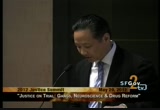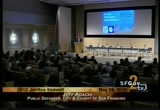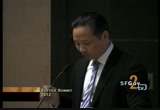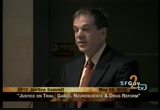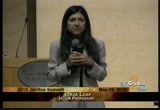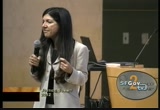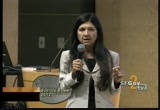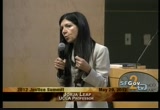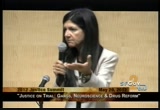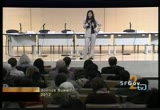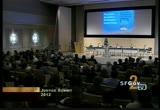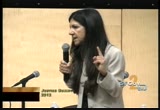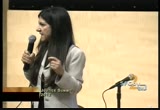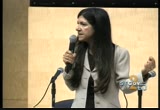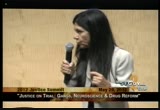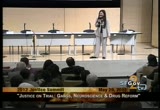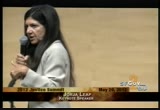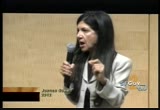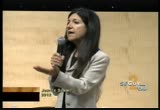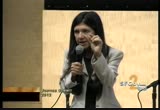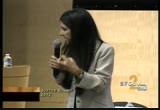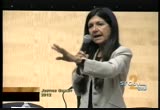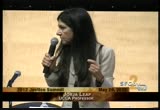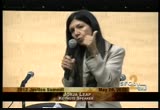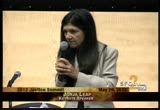tv [untitled] September 6, 2012 2:00am-2:30am PDT
2:00 am
2:01 am
awareness of the issues that affect public safety in criminal and juvenile justice reform. i am proud to say that this is the ninth summit. we take on issues like closing the california youth authority. and we in the confinement of youth -- young children in -- and the prisoner re-entry program and abolishing the death penalty. we take on three critical issues. the first panel has a riveting discussion about gangs. and reducing gang violence. on our panel are former gang members, gang intervention workers, police, public
2:02 am
defenders, and researchers. we talk about strategies to reduce gang violence. i will introduce the keynote speaker in a moment. the second panel is a cutting edge -- cutting edge discussion about the relationship between the human brain and criminal behavior. we have top experts from all parts of the country to talk about what the brain research shows. that is the key to understanding how human beings behave, and why they may commit acts of violence. the afternoon's panel will have a debate about a proposed law that would reduce felony drug possession crimes to a misdemeanor. this is what 13 states have done.
2:03 am
we not only bring these issues to the forefront, but have the opportunity to participate -- and we have cards that you could fill out and questions. this promises to be a year of reform and change like we have never seen, and we now see prisoner reentry programs being implemented. we're still spending too much money and resources and not enough on rehabilitation and reentry. this november, the voters will decide on limiting the three strikes law. issues and measures long overdue. it is clear there is much more that needs to be done. according to a study that was published this month -- since
2:04 am
1989, 2000 people have been wrongfully incarcerated and they served collectively, 10,000 years. an average of 11 years person. i would like to thank the people who made this summit possible. memoranda -- amy devon -- many volunteers and all of our speakers and panelists. i would like to thank the co- sponsors, and the bar association of san francisco. i would like to thank them for their help and support. it is my pleasure to introduce the president elect of the bar association of san francisco.
2:05 am
they provide conflict attorneys to handle cases when a defender is not available. >> i am the president elect of the bar association. we're very proud to co-sponsor the justice of it. on behalf of the 8000 members, and all of those who -- dedicate their careers -- we are very fortunate to have his leadership with top-notch legal representation. for those who were charged each year who are innocent. an important part of the mission is providing equal access to justice.
2:06 am
this is shared by his office and all the public defenders. we're proud of the conflict panel that he described, and we also provide the top-notch representation in matters that his office cannot handle. we applaud you for what you do and for those of you who could not make it, thank you very much. this year's public defender simon will be an interesting day, full of cutting edge issues. gang violence and brain science and crime, these are issues at the forefront and deserve all of our attention. this is a greatat>> your going p with me because i liked to wander around and see faces. you have learned more about me
2:07 am
that a lot of people know. for the last 10 years i have been married to someone who was a deputy chief of the lapd and i now refer to him as being in recovery. at the same time, i have been working extensively with home with industries, and my brother said, if he had dreamed i would be married to a policeman and working with a priest, somebody would be lying. i have been working with gangs and been involved with gangs, trying to figure them out for 34 years. i began as a young social worker in south los angeles. with gang infested housing
2:08 am
projects that are now almost mythic, jordan downs and nickerson gardens, and i worked in these projects during what is referred to as the decade of death, when crack and unregulated gun availability laid waste to communities of color. in los angeles during the late 1980's and early 1990's, there were 1000 homicides per year in the city of los angeles, not the county, the city. now, we have between 203 hundred homicides per year. people talk about the gang problem having been addressed. i want to share with you, what i experienced, what i have learned, i am not a typical
2:09 am
academic. i will not quote statistics to you or talk about theories. i will talk with you about practicality. pragmatic approaches, and i will talk about reality. san francisco, like los angeles learned, will never saw or deal with its gang problems effectively unless there is true collaboration. i will talk to you about what this looks like and feels like. i will speak to you about the lessons that we have learned as law enforcement had to come off of the high perch, in los angeles, law enforcement learned, to their great fortune, that collaboration is
2:10 am
the answer. i am going to talk to you about some of the lessons that were learned. i can tell you first that the people -- we have learned lessons from have been gang members themselves my research is engaged with talking to those current, active gang members and former gang members. i work to collect their life histories. we have over 300 life histories. and still the stories do not stop. what did we learn about people in gangs? i recall early on, sitting down with someone whose gang name was smiley. he is written about in my book.
2:11 am
smiley was a young man of 19, when i first sat down with him at home when industries. one thing he said to me was -- why was no one there for me. why does no one speak to me and why did nobody tried to stop this. he was arrested when he was 16 years old. he was told to lie about his age and say he was 18, so they could be together in jail. and from there his story unfolded. different things were done with him. ultimately, spile -- smiley was helped, but his words haunted me. why did no one speak to me, and why did no one tried to stop me.
2:12 am
i began to listen to the stories of the gang members, and my research team at ucla discovered some startling truths. gang members to leave the gangs. they leave the gang for a variety of reasons. they all have a turning point, when they decide to leave. and it changes them. this would be something that any of you would logically imagine. for female gang members, and we did not see many of them on that video, but they are out there. they are not mothers, they are active gang members. female gang members, the turning point came at the birth of a child. for male gang members, the picture is more complex.
2:13 am
it may be, surprisingly, it may be because they got their second strike, and they're frightened of getting the third. it may be because of the birth of a child, usually a sign. the gang world has not caught up with post-feminist theory. with the story that a gang member named maniac told me, he decided to leave the rolling 60's after 20 years, after achieving status. he was in the back seat of a car, being driven by one of his underlings in the front seat. one of his fellow gang associates got in the back seat with him. the associate said to move over. maniac did not want to move over.
2:14 am
maniac did not want to move over. the associate shoved him over and 10 seconds later, a gun was shot and the bullet came into the car, pierced the associate to the neck and killed him instantly. maniac said, if he had not shoved me aside i would be dead. i am done. that was his turning point. call it a turning point, called the teachable moment. use whatever terminology that you want. that is where we need to be present. when i say we, i mean, we. at that turning point, at that moment of truth, that teachable moment, it is imperative that
2:15 am
resources be brought to bear. now, what are the two most impressive resources that are brought to bear at that moment. there are two major forces that helped gang members change. one of them is tattoo removal. this is the first major force in the denunciation. the second is legal assistance. surprising. you did not see this on the video and i never thought of this. the first thing individuals need, not to feel like gang members -- is to erase their past. they have literally talked with
2:16 am
me about feeling -- removing these tattoos and legal excitement. it is not that simple. changing from being a gang member to a former gang member involves a change in identity. this is a tricky process. it is slow and steady, and there is frustration. the gang is replaced with drugs, and there are fallbacks. relapses, connections, there are struggles. this is where collaboration needs to take hold. it has now become a cliche, to say that we cannot rest on our
2:17 am
way out of this problem. i no longer want to hear those words. this is not to give the law- enforcement a short shrift. i have had an impact on my husband's life, some of the unwanted. but he has had an impact on mind. i have done extensive work with law enforcement, with the lapd and the los angeles county sheriff's. i am here to tell you that crime has been driven down in los angeles because of their efforts, but not only because of their efforts. so what does the collaboration look like. i want you to keep some ideas in mind.
2:18 am
there is no first among equals. what we learned in los angeles was that oppression alone was not the answer. it did not work. there were record highs in gang violence in 2005. i want to tell you what has happened between 2005 and 2012. number one, the grass roots -- the disorganize, fragmented, passionate grass roots must be part of this. the community members who go to county supervisors meetings, the members who pass out fliers, the youths who have been in the juvenile justice system that are now part of the coalition --
2:19 am
those individuals must have a seat at the table. no. 2. community-based organizations. that operate on a shoestring and often without any kind of coverage anywhere. they must be legitimized and made part of the conversation. i have witnessed this with homeboy industries. how many people have heard about this? in california i rarely have to worry. i was in green bay and i started to talk about father greg and no one had any idea what i was talking about. i have known greg boyle for 25 years. i worked with him when he routinely received death threats.
2:20 am
people believed he was trying to help gang members. the lapd called him a hug- hugger. i will repeat everything that they have said, not because of sore afraid of using profanity but because it was a different lapd. it was rumored that the mexican mafia was allowed to meet in his church and that he held guns for gang members. and he was helping gang members across the border. i am certain he knew where the body of jimmy hoffa was buried when you got done listening to the rumors. now, the lapd uses home with industries as an integral part of its anti-gang efforts. not all of them, not 9000
2:21 am
members, but i can tell you this, homeboy industries have their annual benefit to honor people in the community as well as former gang members, the person they honored was chief charliof the lapd. unless you think that was an anomaly, the year before they honored the sheriff. there is an alliance between community-based organizations, and law-enforcement. this is not enough. there has also been in the streets, ongoing, a relationship, a delicate one, a thoughtful one between the loss angeles police department and
2:22 am
gang intervention. interventionists are former gang members. they have to be very careful about how they play out the relationship. they do not want to be snitches. but they want to stop the bleeding. i cannot tell you the complete shock that i have felt as i have sat down with veteran members of the lapd staff, and they talked about the important work of gang intervention. this is not lip service, this is reality. and then i bring up the most important part of collaboration. it has to do with helping young people, whether they are at risk of joining gangs, or if they want to leave gangs.
2:23 am
either one, they need help building their identities. they need help with sang an alternative to the gang life. they need someone who is interested in them. i am going to tell you a story, and i will talk about who those people are. when i was a sweet young thing and a social worker in nickerson gardens, i had that one kid. every gang interventionist, every person in this room knows about that one kid. all of us have that kid. they touch us for reasons we cannot articulate. i don't know why bobby touched me, his name was little devil but i never wanted to call him
2:24 am
by that name. i think about his personality and that maybe the reason. he was 14 years old and had been abused, and was in foster placement with his hat -- aunt. i fell in love with him in the most proper, loving, in the most big sister way. i would say to him, with all the ignorance of the young social worker, i will always be here for you, always. always. it was a friday night, and i had gone on a string of disasters
2:25 am
states, this was in the 1980's. we hooked up, but said we didn't. it was 2:00am and i was getting home. i lived in venice, california. the rent was affordable. but this was to in the morning. the house had a wraparound porch. i was walking up to my house, and there was a shadowy figure on the porch. i did what any concert -- god- fearing a young woman did. i reached for my can of mace, and i was prepared. i looked at the chateau --
2:26 am
shadow, and i heard the voice and knew it was bobby. with all the sensitivity of a new social worker i said, what the -- are you doing here? he told a story that his foster uncle, worked at martin luther king hospital. he convinced his uncle to break into my personnel file. he got my personnel file and my address, there is no transportation in los angeles -- there is nothing. he took three buses and hitchhiked, making it to my old
2:27 am
frame house in venice. i said, why are you here? he said i was in a car and we did drive by and i don't know what to do. you said you would always be there for me. there's the answer and the question. how are we always going to be there for bobby. how are we going to help young people at risk, people who are active, to build new identities? we begin with tattoo removal, legal expunged and and we work on attachment. every individual who wants to avoid being in a gang, who wants
2:28 am
to leave the game, they need a role model and mentor, they need someone to be there. there is no single type of person. we need it the merging of former gang members, prosecutors and social workers and public defenders. you have all had that kid. he needs role models, job training, and real jobs. i was happy to hear that in the video, nothing stops the bullet like a job. we need to provide that. bobbie ann smiley did not ask for their fates. a young woman i worked with, who
2:29 am
has five children and has been a member of valencia 13, and finally once to leave the gang, she did not ask for her fate. we need to listen to the needs -- providing them with jobs, with law enforcement and the community, we need to merge. you need to collaborate. you cannot speak to one another, you need to talk together. this is the challenge. i want to urge everyone in the audience, i take strength from those words, from that question as bobby threw down the gauntlet 30 years ago. you said you would always be you said you would always be there for me.
92 Views
IN COLLECTIONS
SFGTV2: San Francisco Government Television Television Archive
Television Archive  Television Archive News Search Service
Television Archive News Search Service 
Uploaded by TV Archive on

 Live Music Archive
Live Music Archive Librivox Free Audio
Librivox Free Audio Metropolitan Museum
Metropolitan Museum Cleveland Museum of Art
Cleveland Museum of Art Internet Arcade
Internet Arcade Console Living Room
Console Living Room Books to Borrow
Books to Borrow Open Library
Open Library TV News
TV News Understanding 9/11
Understanding 9/11
